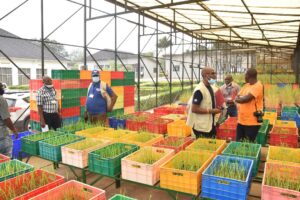Uruguay is a small country in the Southern Cone of South America, located in a corner between the Río de la Plata and the Atlantic Ocean. Rolling hills, excellent natural grasslands, and temperate climate have made the country a perfect place for beef, wool, and dairy production, while typical temperate agriculture has been a tradition since the early period of the Spanish colonization. The country’s traditional products are wheat, barley, sunflower, and maize, with soybean dominating the scene these days.
Rice is a relatively new crop. The first rice fields were recorded back in 1926. In less than 100 years, Uruguay developed an export-oriented rice production system that grew continuously on up to 180,000 hectares. The country has attained high yields and a premium position in the international market. Having a tiny fraction of world rice production, it is seventh on the list of rice-exporting countries, behind only the big players.
Farmer-miller alliance
How ha s this happened in the most intervened and protected grain market in the world? Natural conditions favored rice production with good land, abundant water, and climatic conditions affecting high potential for an irrigated crop. But the key to the country having a competitive and successful position as a rice exporter was the private and public institutional array of support that was constructed over time.
s this happened in the most intervened and protected grain market in the world? Natural conditions favored rice production with good land, abundant water, and climatic conditions affecting high potential for an irrigated crop. But the key to the country having a competitive and successful position as a rice exporter was the private and public institutional array of support that was constructed over time.
Farmers and millers organized the Rice Farmers´ Association (ACA by its Spanish acronym) and the Rice Millers´ Association (GMA by its Spanish acronym) in the late 1940s. Since then, both organizations have been articulating all aspects of the rice agribusiness chain, knowing that each has specific needs and interests, but that both are in the same boat of the rice industry. The best example of this integration is a private rice price agreement, which is based on transparency between ACA and GMA in which, for more than 50 years, the final value the farmer receives depends on the total value of rice from one season (exported and sold internally), less the milling cost and a fixed millers’ gain.
This farmer-miller alliance was reinforced with sound government policies that, without intervening in the markets or with prices, helped producers with roads, electricity for irrigation pumps, opening markets with country-to-country agreements, and farmer and miller loans, among other things.
Institutional innovations
In 1970, Estación Experimental del Este (Eastern Experimental Station) was established, which started local research and innovation for rice. Since its early days, research has been highly integrated with ACA and GMA, thus ensuring well-oriented, demand-focused actions. In 1980, a government–rice sector agreement channeling private funds to Estación Experimental del Este started the research investment of farmers and millers in Uruguay.
Estación Experimental del Este became INIA Treinta y Tres, with the creation of the National Institute for Agricultural Research (Instituto Nacional de Investigación Agropecuaria, INIA) in 1989. INIA was established as an institutional innovation that had its roots in the rice farmers’ experience, in which government and farmers’ funds come together. This is recognized in the Institute board, of which half of the members are elected by the Ministry and half by farmers’ associations.
In the last 40 years, a whole technological revolution based on local research took place, resulting in the highly competitive indicators today. Now, 90% of the area is planted with national varieties, which were developed by considering not only agronomic and high-yielding traits but also the highest standards of grain quality, and taking into account the markets to which Uruguay exports.
All rice is planted in dry soils with minimum tillage and using no-till planters that are adapted for planting over levees. The country’s rice production is extensively mechanized, with an average farm size of 300 hectares. Rice is planted in rotation with pastures, with a typical rotation of two years of rice and three years of grasses and legumes, which allow for highly productive cattle farming. This low-intensity rotation system improves sustainability because it reduces pest and disease pressure and maintains good soil conditions. This crop technology package is carefully followed by most farmers. The national average yield reached 8 tons per hectare in the last five years, with top farmers surpassing 10 tons per hectare.
Well-organized farmers’ and millers’ groups, sound government policies, and an articulated research and innovation system brought the institutional framework to success. This has become possible even without any kind of subsidy, without a domestic market to rely on (Uruguay’s local market is only 5% of the rice it produces per year), and depending on highly volatile international markets (95% of the rice is exported).
Competitiveness is the name of the game for Uruguayan rice farmers and the race is never over. Now, they are figuring out how to profit with increasing production costs and weaker rice prices, and pressing for new technologies to further increase yield potential.
_________________________________________
Mr. Zorrilla is the director of the National Research Program at the National Institute of Agricultural Research in Uruguay and a member of the Rice Today editorial board.










Good afternoon. We are located in Ecuador. We import fertilizer into Ecuador and sell it to different crops growers. Presently we are working with ric growers looking to increase production and – at the same – to avoid adding too much fertilizers – we are mainly worried about the fertilizers with high concentrations of Na and Cl as Potassium Cloruro- to the soil. We need your help to get a good fertilization rate per ha. or per acre recomendation…those rates you find fine in other countries…..we are aware about every soil and climate conditions being different